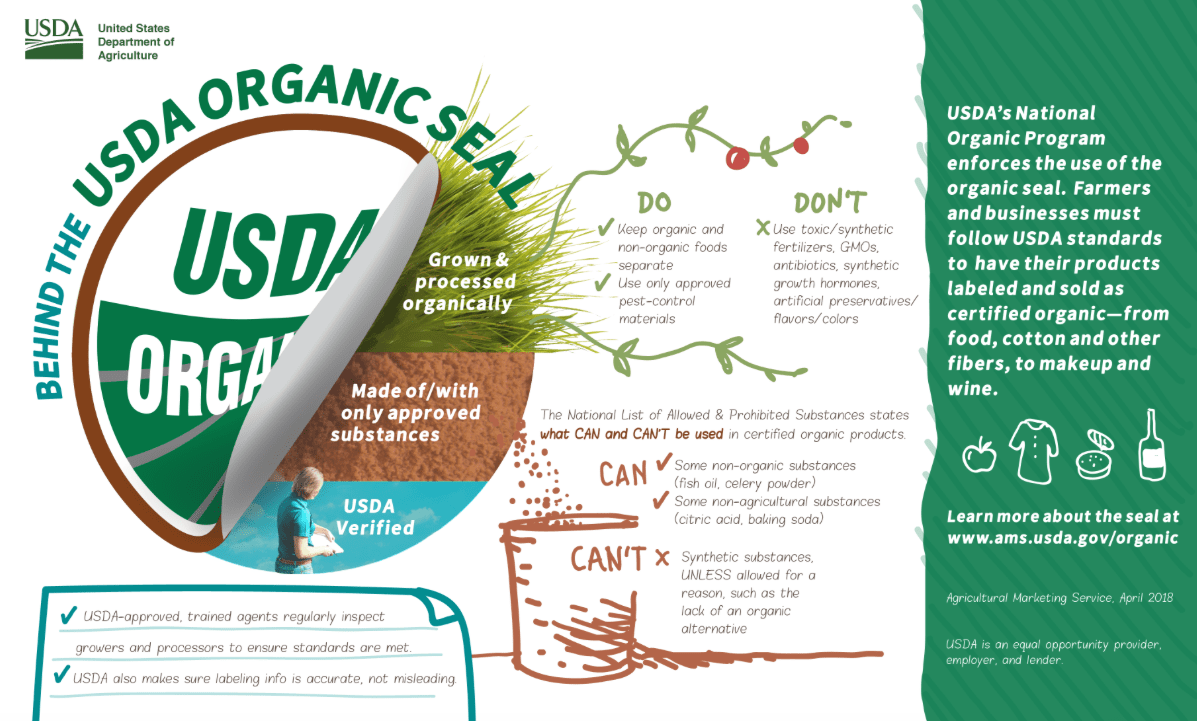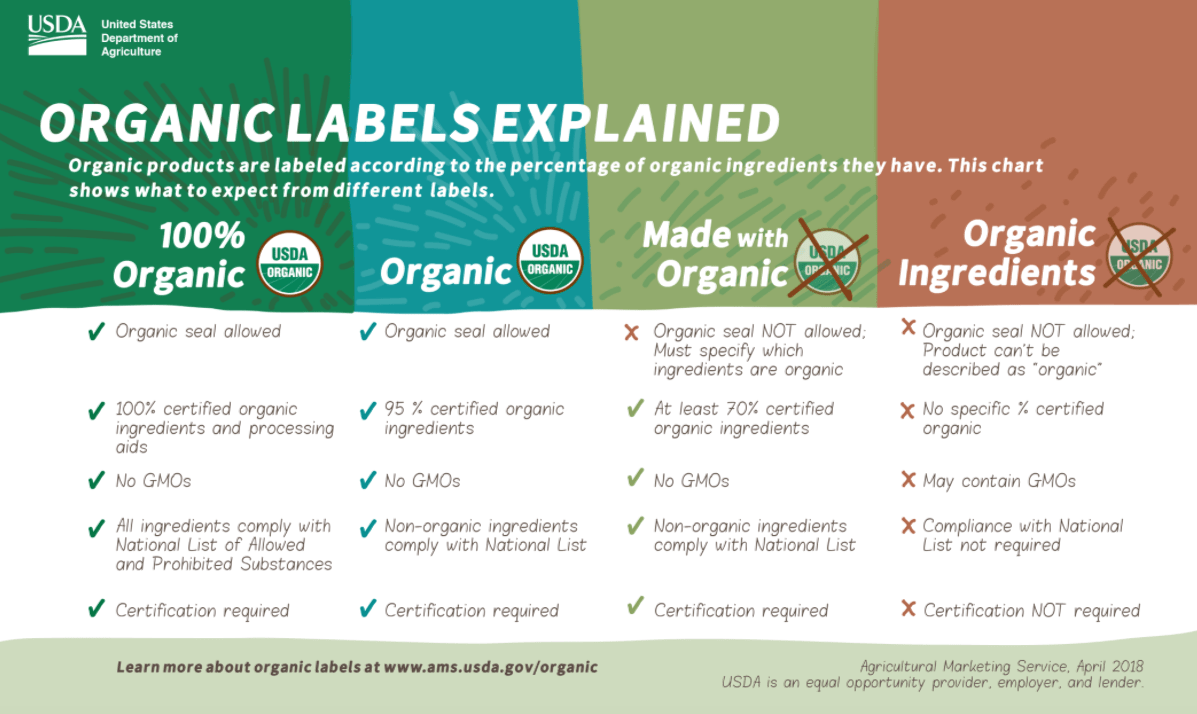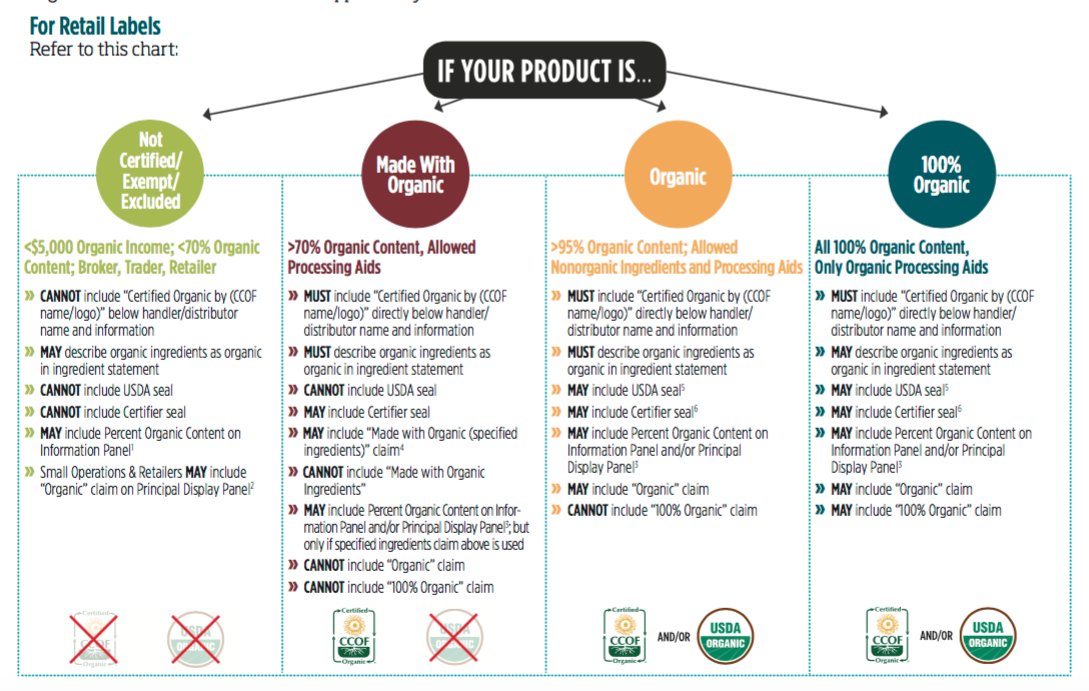Some of the products recommended or links used in this post are affiliates. By purchasing through the link you are allowing me to earn a small commission at no extra charge to you.
Hello Greenie,
Shopping in the grocery store is always a little bit intimidating when you see labels jumping out at you claiming to be organic, 100% natural, or made with organic ingredients. This all sounds well and good, but what does it actually mean? What’s the difference between all these? Do you know? If not, that’s where food companies want to keep you; Not knowing. The truth and reality is that most of these labels do not actually mean what you think they mean.
Natural
So sadly natural just doesn’t mean natural anymore. Whether you are talking about food, makeup, cleaning solutions, or laundry detergent; natural just doesn’t cut it for meeting the mark on clean ingredients. Back in 1991 the FDA loosely defined natural, but never fully regulated the claims businesses were making when putting this word on their products. With their backs turned and little regulations on this, companies began to use and abuse this word to the point of no recognition. It wasn’t until worried consumers cried out to the FDA to better define what in fact “natural” meant that the FDA seemed to acknowledge it. And what did they do? They cried back to the public, “Help us! What do we do?”. They actually wanted public opinion on how to better define this word, but in the mean time this was their definition according to their website:
The FDA has considered the term “natural” to mean that nothing artificial or synthetic (including all color additives regardless of source) has been included in, or has been added to, a food that would not normally be expected to be in that food. However, this policy was not intended to address food production methods, such as the use of pesticides, nor did it explicitly address food processing or manufacturing methods, such as thermal technologies, pasteurization, or irradiation. The FDA also did not consider whether the term “natural” should describe any nutritional or other health benefit.
According to this food production methods like genetically modified organisms means natural; spraying chemical pesticides means natural; giving antibiotics, steroids, hormones and vaccines means natural; and inhumanely raising and slaughtering animals means natural.
I don’t know about you, but to me none of the above sounds natural. If you come across a product that claims to be natural, try looking on the label for other certifications or words, like: USDA Organic, CCOF Certified Organic, Non-GMO, Certified Naturally Grown, Animal Welfare Approved, American Humane Certified, American Grassfed, Pature Raised, Hormone Free, RBGH Free, and Raised Without Antibiotics. Now that consumers are becoming increasingly more weary of what is in their food, new certifications are poping up left and right. Companies trying to look out for your health and the health of the planet will proudly sport these labels. Certifications and words like these help to ensure that you are truly getting a natural product.
Non-GMO
I am sure most of you know or have heard of GMOs by now. According to Non-GMOProject.org GMOs (Genetically Modified Organisms) are plants, animals, microorganisms or other organisms whose genetic makeup has been modified in a laboratory using genetic engineering or transgenic technology. A lot of times, for plants, this process is done to the seed. Scientists modify seeds to try and create a better tasting, higher yielding, more attractive, pest resistant plant. Pretty much, they try to play God, and in doing so there is no telling what kind of impacts this unnatural impact can have on our health. GMO’s are still failry new for research to have studied the long term effects it can have, but I, like most, am saying “N-O to GMO!”
In the US it is not required for companies to label that their ingredients are GMO, and it wasn’t until 2010 that the Non-GMO project had released their first products carrying the Non-GMO seal. Now, tons of companies are jumping on the band wagon trying to show customers their products are the real deal.
If a product does not contain the Non-GMO seal, it does not necessarily mean it does contain GMO ingredients, however, if it is on the high risk list then chances are pretty good it is GMO.
100% Organic
Buying food labeled “100% organic” is the best option you can find. Unlike the “natural” label, to claim an organic seal the farmer or business must follow strict guidlines that are thoroughly inspected by the National Organic Program. This means that absolutely everything labeled on that ingredients list follows the USDA’s standards for organic production and processing; from seed to shelf. Being labeled organic all ingredients are also automatically GMO free, as part of the organic guidelines. No GMO seal is needed, but it can be labeled to make for easy reading for the consumer. Being labeled organic also means that soil quality is monitored; and only approved pesticides, herbicides and fertilizers are used. When buying organic meats, dairy and eggs it means that no hormones or antibiotics are used and they get fed organic feed.
Organic
Surprisingly, buying products labeled “organic” does not mean all of the ingredients are organic. To wear the organically certified label, only 95% of the ingredients need to be truly organic. The remaining 5% then follows the National List, which according to the USDA states:
In general, synthetic substances are prohibited unless specifically allowed and non-synthetic substances are allowed unless specifically prohibited. For example, a vaccine used to prevent pinkeye in livestock is an allowed synthetic substance and arsenic is an example of a prohibited natural substance.
All organic ingredients must be labeled and none of the ingredients can be genetically modified. Products labeled 100% Organic or Organic are the only ones that can carry the USDA Organic seal.
Made with Organic Ingredients
To state on the packaging that there are multiple ingredients “made with organic ingredients”, the product needs 70% of its ingredients to be organic. The remaining 30% follows the National List guidlines. Products made with multiple or majority of organic ingredients are still monitored by the National Organic Program, but they are not able to put the organic seal on their labels. They too must also specify on the ingredients label which ingredients are organic and cannot use any GMO ingredients.
Organic Ingredients
When it comes to claiming that there is a specific item that is an “organic ingredient”, it appears that there really is no strict guideline as to what qualifies.There is no percentage that needs to be organic, they do not even need to follow the National List, they are not regulated by the National Organic Program, and the product can be made using GMO ingredients. Basically, buying something that simply states an organic ingredient does not even necessarily mean you are getting an “organic” product. You just may be paying more for a product with pretty packaging and a drop of an organic ingredient.
**the above infographic is taken from the USDA website**
Certified Naturally Grown
The Certified Naturally Grown (CNG) label has guidelines that mimic the USDA organics guidelines. However, CNG is a private non-profit organization that is not affiliated with the National Organic Program. This certification is geared towards small, usually family-owned farms where obtaining a USDA organic seal would be too costly and tideous. Though these products cannot label themselves officially as organic, they are monitored by fellow farmers to inspect that their products and farms are being held to an organic standard.
CNG uses a totally transparent business model, with all the farm’s inspection reports and declarations viewable in their profile at CNGfarming.org. To find a local farm near you, access CNG’s database to find certified farmer’s all throughou the United States and Canada.
California Certified Organic Farmers
California Certified Organic Farmers (CCOF) is a non-profit organization that advocates for organic policies. They were founded in 1973, even before the USDA’s National Organic Program, and helped to push the organic movement. CCOF certified farmers follow all the USDA organic guidelines. CCOF certified may be made with 70% of organic ingredients or more, and their labeling guidelines follow the USDA’s.
**the above infographic is taken from the CCOF website**
Farmer’s Markets and Shopping Small
The best way to ensure you are getting quality food is to get to know your local farmers by shopping at farmer’s markets or health food stores that support local farmers. Small farmers tend to be more transparent and easier to access to ask questions. Eat Wild is a site that allows you find farmers in your area that sell grass fed meats, dairy, eggs, and even wild caught fish. To learn more about food labels check out their PDF on A Consumer’s Guide to Food Labels And Animal Welfare.
Local Harvest is another useful site that allows you to shop for farms, farmer’s markets, and even restaurants that sell quality food. Yum yum!
I hope this helps, and makes reading those labels maybe a little less intimidating, and your shopping experience a little more enjoyable! Happy shopping Greenie!

This post uses affiliate links which allows me to earn a small commission at no extra cost to you.
By purchasing these products you are supporting me and making it possible for me to bring you more content.





Awesome information! I learned a lot and it was easy to understand!